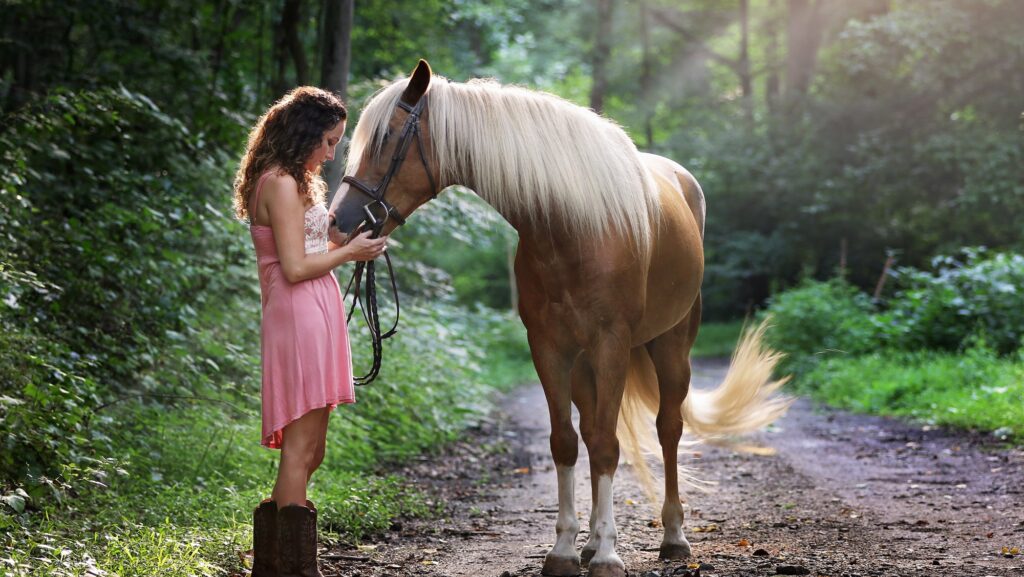Many of us are animal lovers, feeling at ease when petting a dog or playing with a cat. Connecting with an animal, a horse included, can be calming and create a sense of safety and purpose. Animals affect how we feel and teach us many lessons in treatment and recovery. Focused time and working with animals is a way to see improvement in recovery with less structure than typical talk therapy. It can provide a break from talk therapy while still helping us work to improve and recover.
Equestrian Therapy
Horse-assisted therapy (HAT) is categorized as a type of animal-assisted therapy (AAT). HAT utilizes horses in conjunction with other therapeutic modalities to improve overall mental health. This type of therapy is overseen by a mental health professional who has specific goals in mind for each client.
Working with and around horses can be valuable and enjoyable in itself. However, the therapeutic communication that occurs throughout a HAT session is a part of what makes this type of therapy effective for recovery. HAT teaches many skills that can help us in recovery, including the following:
- How to balance and work through emotions
- The effect of our feelings on others
- Non-verbal communication and what our posture and cues are saying to others
- Assertiveness
- How to build a connection, and how it feels
- Boundaries, setting them and reading others
- Mental focus
Spending time with horses and learning to build a connection improves our ability to spend time connecting with others. The vital skills learned in HAT improve our overall sense of community which is highly important in the success of recovery.
Working With Horses
There are many qualities of horses that make them well suited for a therapeutic role.
Awareness
Horses are herd animals, which means they are often prey in the wild. As a result, they are highly aware of a situation and can quickly read another person’s or animal’s emotions.
These animals have a keen sense of a person’s energy, whether it be anger, sadness, etc. Some of us in recovery cannot connect with our feelings or may have a hard time finding the words to express our feelings. We can use horses like a mirror, seeing their response to how we feel and act, which can improve our awareness of ourselves.
Connection
Like other animals, horses are capable of non-verbal social connections. These animals do not connect by us asking them questions and learning about their history. Instead, they react to our feelings and connect, helping us build trust and communicate with them.
For us, this can be an incredible experience where we do not have to talk. Horses do not care about our history but instead want to connect with us in the present based on the energy and emotions that we have.
Communication
Working with a horse takes time, effort, and focus. Horses are large animals, and learning to communicate effectively is a skill. How do we let the horse know they have overstepped into our space? How do we guide them where we want them to go?
These are skills that are taught as a part of HAT. Learning to work with horses can aid communication with people and build confidence in our abilities to learn a new skill. The skills we learn in HAT can show us that there are options out there, beyond and outside of our substance abuse.
HAT for Addiction Recovery
While HAT is utilized for many different issues, including trauma, post-traumatic stress disorder (PTSD), depression, and anxiety, it is especially effective for addiction recovery. A study published in Addiction Science & Clinical Practice found a statistically significant association between HAT and time, participation, and completion of treatment. While more research is needed to show a causal link, this does provide preliminary evidence of the effectiveness of HAT.
Another study by Substance Abuse: Research and Treatment looked at HAT to determine what aspects were helpful to clients and what their experience was like. Researchers found that four crucial and interrelated aspected were reported:
- A change of focus by paying attention to the work at hand can improve mindfulness and create a sense of calm
- Completing a useful activity and feeling useful by participating in the caretaking of horses
- An identity outside of addiction or being seen as a person separate from substance abuse
- Motivation to continue with treatment due to feelings of joy
Although experience differs for each individual, HAT is one type of AAT that works incredibly well for some. The unique blend of therapeutic communication, physical work, and animal connection can help us to create and maintain change.
Many of us can feel defined by our mistakes, getting caught in the identity of our past. Talk therapy is beneficial in addiction recovery, but alternative therapies can sometimes help us process our past. Learning to take care of, communicate, ride, and perform different tasks with horses is a highly effective method for treatment outcomes. As you learn the skills needed to communicate with horses, you gain insight into your emotions, learn how your non-verbal communication affects others, and how to draw and respect boundaries. At 449 Recovery, we believe in treating our clients with a whole person-centered approach. Our blend of traditional and alternative therapies can help you find the healing you deserve. Through our programs, you can overcome trauma, mental health disorders, and addiction, helping you find a new way to live. For more information on 449 Recovery and how we can help you, call (949) 435-7449.

Dr. Warren Taff MD, graduated from the University of Birmingham, England School of Medicine, with a BA from Rutgers University. He then went on to UCLA School of Public Health in Los Angeles Health and Human Services and received an MPH. He also attended an internship in internal medicine, with the Veterans Administration. Dr. Taff’s residency includes General Psychiatry at USC, with elective residencies at the Royal Prince Alfred Hospital in Sydney, Australia, and Royal College of Psychiatry. Board certifications include American Board of Psychiatry and Neurology. Dr. Taff has extensive experience in both psychiatry and addiction medicine, extending from 1979 to present. He has held professional titles that include Chief of Staff and Medical Directorship in both hospitals and private sectors.






